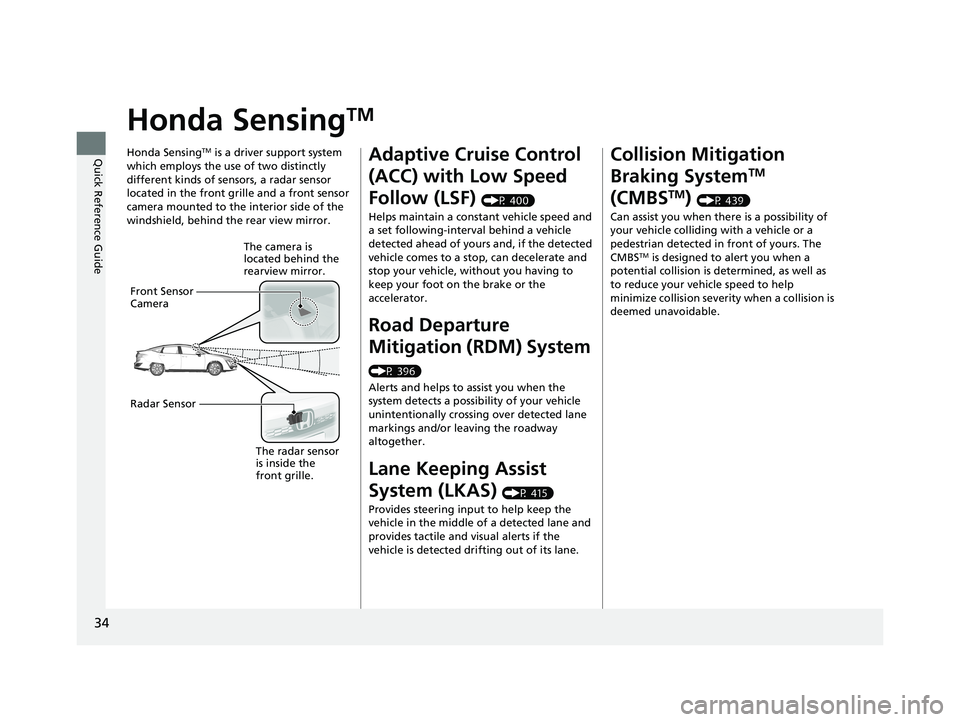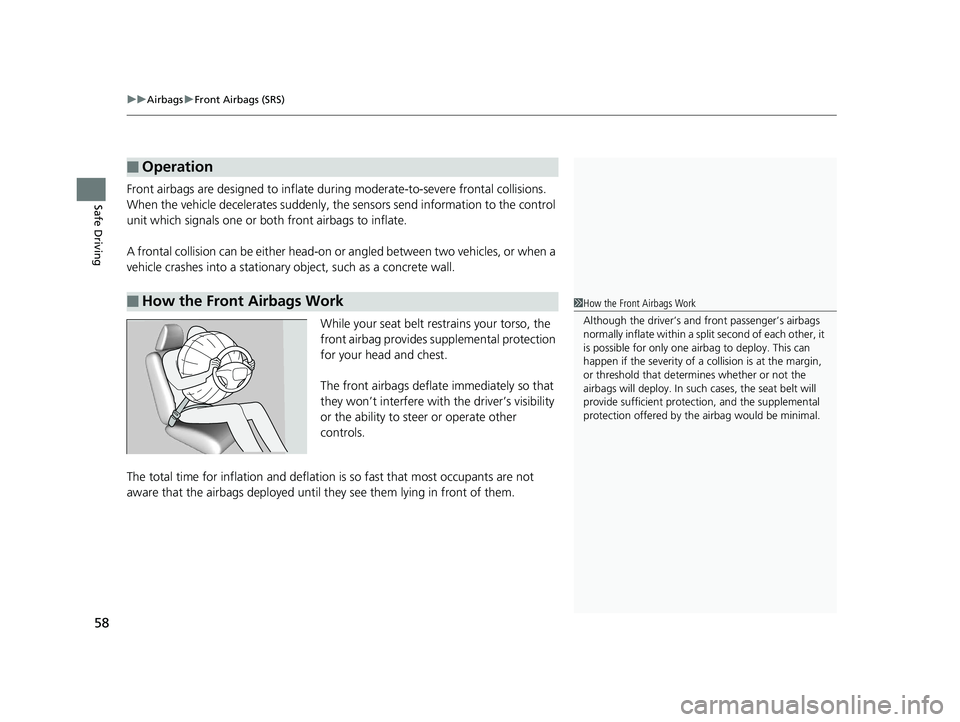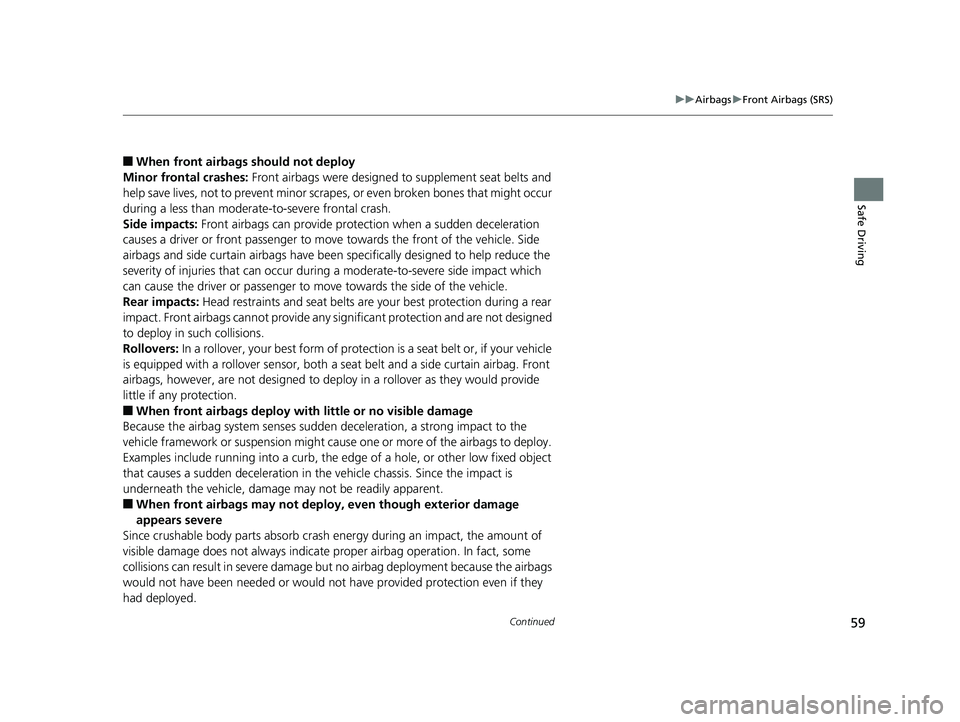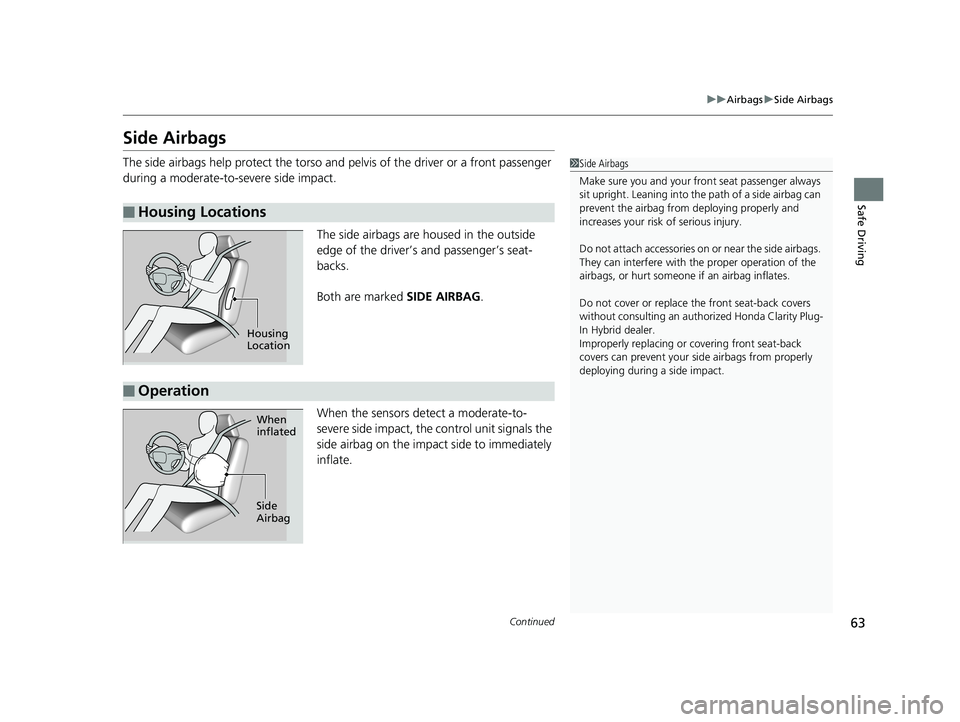2018 HONDA CLARITY PLUG IN HYBRID sensor
[x] Cancel search: sensorPage 36 of 591

34
Quick Reference Guide Honda Sensing TMHonda Sensing TM
is a driver support system
which employs the use of two distinctly
different kinds of sensors, a radar sensor
located in the front grille and a front sensor
camera mounted to the interior side of the
windshield, behind the rear view mirror.
The camera is
located behind the
rearview mirror.
Front Sensor
Camera
Radar Sensor
The radar sensor
is inside the
front grille.Adaptive Cruise Control
(ACC) with Low Speed
Follow (LSF) (P 400)
Helps maintain a constant vehicle speed and
a set following-interval behind a vehicle
detected ahead of yours and, if the detected
vehicle comes to a stop, can decelerate and
stop your vehicle, wi thout you having to
keep your foot on the brake or the
accelerator.
Road Departure
Mitigation (RDM) System (P 396)
Alerts and helps to assist you when the
system detects a possibility of your vehicle
unintentionally crossing over detected lane
markings and/or leaving the roadway
altogether.
Lane Keeping Assist
System (LKAS) (P 415)
Provides steering input to help keep the
vehicle in the middle of a detected lane and
provides tactile and visual alerts if the
vehicle is detected drifting out of its lane.Collision Mitigation
Braking System TM
(CMBS TM
) (P 439)
Can assist you when there is a possibility of
your vehicle colliding with a vehicle or a
pedestrian detected in front of yours. The
CMBS TM
is designed to alert you when a
potential collision is determined, as well as
to reduce your vehicle speed to help
minimize collision severity when a collision is
deemed unavoidable.18 CLARITY PHEV CSS-31TRW6000.book 34 ページ 2017年8月31日 木曜日 午後2時 49分
Page 51 of 591

49 uu Seat Belts u About Your Seat Belts
Safe Driving
The seat belt system includes an indicator on
the instrument panel to remind the driver or a
front passenger or both to fasten their seat
belts.
If you set the power mode to ON and a seat
belt is not fastened, a beeper will sound and
the indicator will blink. After a few seconds,
the beeper will stop and the indicator will
come on and remain illuminated until the seat
belt is fastened.
The beeper will periodically sound and the
indicator will blink while the vehicle is moving
until the seat belt is fastened.
The front seats are equi pped with automatic
seat belt tensioners to enhance safety.
The tensioners automatically tighten the front
seat belts during a moderate-to-severe frontal
collision, sometimes even if the collision is not
severe enough to inflate the front airbags or
the driver’s knee airbag.■ Seat Belt Reminder 1 Seat Belt Reminder
The indicator will also co me on if a front passenger
does not fasten their seat belt within six seconds after
the power mode is set to ON.
When no one is sitting in th e front passenger’s seat,
the indicator will not come on and the beeper will not
sound.
The indicator also may no t come on and the beeper
may not sound when the occupant is not heavy
enough to trigger the weight sensor. Such occupants
(e.g., infants and smaller children) should be moved
to the rear seat as a deploying front airbag likely will
injure or kill them.
2 Protecting Child Passengers P. 69
■ Automatic Seat Belt Tensioners 1 Automatic Seat Belt Tensioners
The seat belt tensioners can only operate once.
If a tensioner is activated, the SRS indicator will come
on. Have an authorized Ho nda Clarity Plug-In Hybrid
dealer replace the tensi oner and thoroughly inspect
the seat belt system as it may not offer protection in
a subsequent crash.
During a moderate-to-severe side impact, the
tensioner on that side of the vehicle also activates.18 CLARITY PHEV CSS-31TRW6000.book 49 ページ 2017年8月31日 木曜日 午後2時 49分
Page 57 of 591

55uu Airbags u Airbag System Components
Continued
Safe Driving
The front, driver’s knee, front side, and side
curtain airbags are de ployed according to
the direction and severity of impact. Both
side curtain airbags are deployed in a
rollover. The airbag system includes:a
Two SRS (Supplemental Restraint System)
front airbags. The driver’s airbag is stored
in the center of the steering wheel; the
front passenger’s airbag is stored in the
dashboard. Both are marked SRS
AIRBAG .b
Driver’s knee airbag. The knee airbag is
stored under the steer ing column. It is
marked SRS AIRBAG .c
Two side airbags, one for the driver and
one for a front passenger. The airbags are
stored in the outer edges of the seat-
backs. Both are marked SIDE AIRBAG .d
Two side curtain ai rbags, one for each
side of the vehicle. The airbags are stored
in the ceiling, abov e the side windows.
The front and rear pillars are marked
SIDE CURTAIN AIRBAG . e
An electronic control unit that, when the
vehicle is on, continually monitors
information about the various impact
sensors, seat and buckle sensors, rollover
sensor, airbag activators, seat belt
tensioners, seat weight sensor, seat
position sensor, passenger airbag OFF
indicator, and other vehicle information.
During a crash event the unit can record
such information. f
Automatic front seat belt tensioners. In
addition, the driver’s and front
passenger’s seat belt buckles incorporate
sensors that detect whether or not the
belts are fastened. g
A driver’s seat position sensor. This
sensor determines the optimal force at
which the airbag will deploy in a crash. h
Weight sensors in the front passenger’s
seat. The front passenger’s airbag will be
turned off if the weight on the seat is
approximately 65 lbs (29 kg) or less (the
weight of an infant or small child). i
Impact sensors that can detect a
moderate-to-severe front or side impact. j
An indicator on the dashboard that alerts
you that the front passenger’s front
airbag has been turned off. k
An indicator on the instrument panel that
alerts you to a possible problem with your
airbag system or seat belt tensioners. l
A rollover sensor that can detect if your
vehicle is about to ro ll over and signal the
control unit to deploy both side curtain
airbags.18 CLARITY PHEV CSS-31TRW6000.book 55 ページ 2017年8月31日 木曜日 午後2時 49分
Page 60 of 591

uu Airbags u Front Airbags (SRS)
58
Safe Driving Front airbags are designed to inflate during moderate-to-severe frontal collisions.
When the vehicle decelerates suddenly, the sensors send information to the control
unit which signals one or both front airbags to inflate.
A frontal collision can be either head-on or angled between two vehicles, or when a
vehicle crashes into a stationary object, such as a concrete wall.
While your seat belt restrains your torso, the
front airbag provides supplemental protection
for your head and chest.
The front airbags deflate immediately so that
they won’t interfere with the driver’s visibility
or the ability to steer or operate other
controls.
The total time for inflation and deflation is so fast that most occupants are not
aware that the airbags depl oyed until they see them lying in front of them.■ Operation
■ How the Front Airbags Work 1 How the Front Airbags Work
Although the driver’s and fr ont passenger’s airbags
normally inflate within a spli t second of each other, it
is possible for only one airbag to deploy. This can
happen if the severity of a collision is at the margin,
or threshold that determines whether or not the
airbags will deploy. In such cases, the seat belt will
provide sufficient protec tion, and the supplemental
protection offered by the airbag would be minimal.18 CLARITY PHEV CSS-31TRW6000.book 58 ページ 2017年8月31日 木曜日 午後2時 49分
Page 61 of 591

59 uu Airbags u Front Airbags (SRS)
Continued
Safe Driving
■ When front airbags should not deploy
Minor frontal crashes: Front airbags were designed to supplement seat belts and
help save lives, not to prevent minor scrape s, or even broken bones that might occur
during a less than moderate-to-severe frontal crash.
Side impacts: Front airbags can provide protecti on when a sudden deceleration
causes a driver or front passenger to move towards the front of the vehicle. Side
airbags and side curtain airbags have been specifically designed to help reduce the
severity of injuries that can occur during a moderate-to-severe side impact which
can cause the driver or passenger to move towards the side of the vehicle.
Rear impacts: Head restraints and seat belts ar e your best protection during a rear
impact. Front airbags cannot provide any significant protection and are not designed
to deploy in such collisions.
Rollovers: In a rollover, your best form of protection is a seat belt or, if your vehicle
is equipped with a rollover sensor, both a seat belt and a side curtain airbag. Front
airbags, however, are not designed to depl oy in a rollover as they would provide
little if any protection.
■ When front airbags deploy with little or no visible damage
Because the airbag system senses sudden deceleration, a strong impact to the
vehicle framework or suspension might caus e one or more of the airbags to deploy.
Examples include running into a curb, the edge of a hole, or other low fixed object
that causes a sudden deceleration in th e vehicle chassis. Since the impact is
underneath the vehicle, damage may not be readily apparent.
■ When front airbags may not deploy , even though exterior damage
appears severe
Since crushable body parts absorb crash energy during an impact, the amount of
visible damage does not always indicate proper airbag operation. In fact, some
collisions can result in severe damage but no airbag deployment because the airbags
would not have been needed or would not have provided protec tion even if they
had deployed. 18 CLARITY PHEV CSS-31TRW6000.book 59 ページ 2017年8月31日 木曜日 午後2時 49分
Page 62 of 591

uu Airbags u Front Airbags (SRS)
60
Safe Driving The airbags have advanced features to help reduce the likelihood of airbag related
injuries to smaller occupants.
The driver’s advanced ai rbag system includes a
seat position sensor.
Based on information from this sensor and the
severity of the impact, the advanced airbag
system determines the optimal deployment of
the driver’s airbag.
The front passenger’s ad vanced airbag system
has weight sensors.
We advise against allowing a child age 12 or
under to ride in the front passenger’s seat.
However, if you do allow a child age 12 or
under to ride in the front passenger’s
seat , note that the system will automatically
turn off the front passenger’s airbag if the
sensors detect that the child is approximately
65 lbs (29 kg) or less.■ Advanced Airbags 1 Advanced Airbags
If there is a problem with the driver’s seat position
sensor, the SRS indicator wi ll come on, and in the
event of a crash, the airbag will deploy (r egardless of
the driver’s seating position) with a force
corresponding to the se verity of the impact.
For the advanced airbags to work properly:
• Do not spill any liquid on or under the seats.
• Do not put any object under the passenger’s seat.
• Make sure any objects are positioned properly on
the floor. Improperly pos itioned objects can
interfere with the advanced airbag sensors.
• All occupants should sit upri ght and wear their seat
belts properly.
• Do not cover the passenger ’s side dashboard with
a cloth, towel, cover, etc.
2 Passenger Front Airbag Off Indicator P. 67
Make sure the floor mat behind the front passenger's
seat is hooked to the floor mat anchor. An improperly
placed mat can interfere with the advanced airbag
sensors.
2 Floor Mats P. 514Driver’s
Seat
Position
Sensor
Passenger’s
Seat
Weight
Sensors18 CLARITY PHEV CSS-31TRW6000.book 60 ページ 2017年8月31日 木曜日 午後2時 49分
Page 65 of 591

63 uu Airbags u Side Airbags
Continued
Safe Driving
Side Airbags The side airbags help protect the torso and pelvis of the driver or a front passenger
during a moderate-to-severe side impact.
The side airbags are housed in the outside
edge of the driver’s and passenger’s seat-
backs.
Both are marked SIDE AIRBAG .
When the sensors detect a moderate-to-
severe side impact, the control unit signals the
side airbag on the impact side to immediately
inflate.■ Housing Locations 1 Side Airbags
Make sure you and your front seat passenger always
sit upright. Leaning into the path of a side airbag can
prevent the airbag from deploying properly and
increases your risk of serious injury.
Do not attach accessories on or near the side airbags.
They can interfere with the proper operation of the
airbags, or hurt someone if an airbag inflates.
Do not cover or replace the front seat-back covers
without consulting an author ized Honda Clarity Plug-
In Hybrid dealer.
Improperly replac ing or covering front seat-back
covers can prevent your si de airbags from properly
deploying during a side impact.Housing
Location
■ Operation When
inflated
Side
Airbag18 CLARITY PHEV CSS-31TRW6000.book 63 ページ 2017年8月31日 木曜日 午後2時 49分
Page 66 of 591

64 uu Airbags u Side Airbags
Safe Driving ■ When a side airbag deploys with little or no visible damage
Because the airbag system senses sudden acceleration, a strong impact to the side
of the vehicle’s framework can cause a side airbag to deploy. In such cases, there
may be little or no damage, but the side impact sensors detected a severe enough
impact to deploy the airbag.
■ When a side airbag may not deploy, even though visible damage appears
severe
It is possible for a side airbag to not deploy during an impact that results in
apparently severe damage. This can occur when the point of impact was toward the
far front or rear of the vehicle, or when the vehicle’s crushable body parts absorbed
most of the crash energy. In either case , the side airbag wo uld not have been
needed nor provided protection even if it had deployed.18 CLARITY PHEV CSS-31TRW6000.book 64 ページ 2017年8月31日 木曜日 午後2時 49分